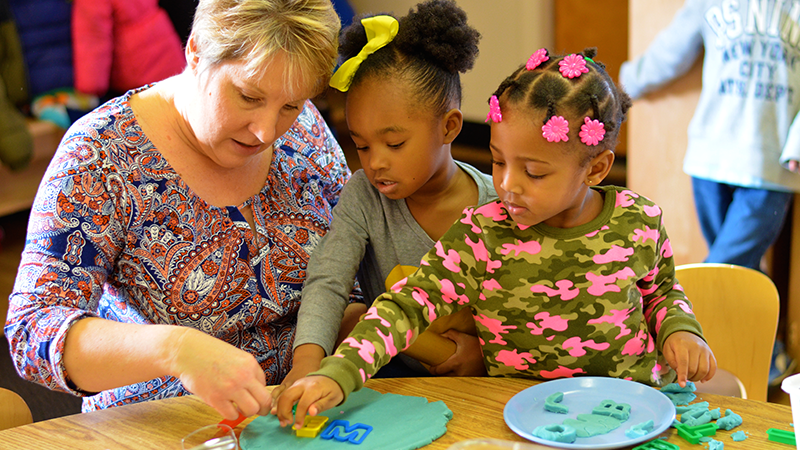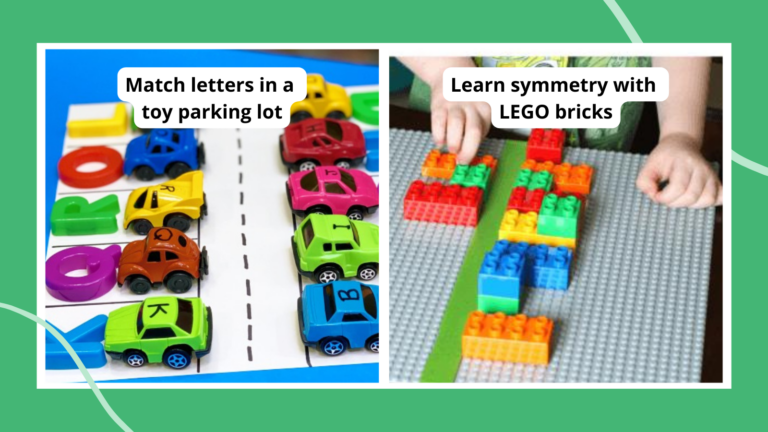Do you know where the most sophisticated thinking happens in your preschool classroom? It’s not necessarily at circle time, not while learning letters, and not while learning to count. The time spent at the easel, in the dramatic-play area, and with the play dough you set out every morning—time spent doing creative arts in early childhood—has the potential to be the most impactful part of your curriculum.
According to early childhood expert Ann Epstein, author of the book Arts Smart, “studies consistently show that when the arts are part of the core curriculum, students are more task-focused, persistent, cooperative with one another and emotionally invested in learning overall.” There are five main areas to consider when you’re trying to include the creative arts in your classroom: visual art, music, movement, art appreciation and dramatic (pretend) play. We’ve collected five of our favorite creative arts activities that are easy to implement and designed to maximize the potential for critical thinking and higher-level cognitive processes.
1. Make a multimedia collage.

Overview: Children make collages from scrap materials (leftover paper, fabric, netting, toilet paper tubes, plastic lids, etc.).
Creative arts area: Visual art
Materials:
- Scrap materials as needed (e.g., paper scraps, fabric scraps, wood scraps, yarn, netting).
- Sheets of construction paper, cardboard or other sturdy paper on which to make the collages.
- Fasteners, such as tape and glue.
- Damp sponges and paper towels for wiping up drips and spills.
How to do it:
Provide children with their own bin of materials to build their creations. It might help to ask them a few questions to guide their process while they work, and encourage conversation. I like to engage my students by suggesting that they “tell me about what you are making.” Or sometimes I look for more specific information, such as “Tell me about your plan for the buttons you have there.” Describe the steps children are taking as they create their art; for example, “I see you made a shiny collage by gluing foil onto your paper.” You can also make comments that incorporate key vocabulary: “I notice you’re putting a circle on your artwork.”
Don’t expect children to create a symbolic representation of an actual item, such as a picture of a dog or a person. For younger children, it may be all about the process: feeling the glue, touching the fabric. As children get older, they’ll begin to consider other ways to create with the materials.
Why it’s higher-level thinking:
In addition to all of the vocabulary you add to the activity when you talk with children, brain research shows that when children engage in visual art, it excites the parts of their brains that allow them to recall or create fantasy. Creative, open-ended art activities, such as collage making, build executive function because they encourage children to plan, evaluate and adjust their behaviors to reach a goal.
2. Sing with parachutes.

Overview: Children explore the range of their voices by modifying the pitch of their voices as they raise and lower a parachute.
Creative arts area: Music
Materials:
- A class-size parachute.
How to do it:
Find a large space and gather the children around the parachute. In addition to your usual fun parachute games, mix in this one that involves a little music and noisemaking. Demonstrate for the children the difference between high-pitch sounds and low-pitch sounds. Then match the high-pitch sounds to when the parachute is raised high and the low-pitch sounds to when the parachute is low. Ask the children to join you in making high- and low-pitch sounds to match the parachute position. As some of the children begin to grasp this concept (not all of them will be developmentally ready, but some will), begin to raise and lower your voices as you and the children raise and lower the parachute so that your voices slide up and down the musical scale. With older children, you can also ask them to direct the placement of the parachute to high, medium or low. Then they can match their voices to where the parachute is placed.
Why it’s higher-level thinking:
Brain researchers have discovered that music stimulates the auditory and emotional areas, which creates pleasant feelings for melodic sounds and unpleasant feelings for dissonant sounds. Amazingly, we begin to notice these things even as toddlers. The same researchers also discovered connections between the areas of the brain that process music and the parts of the brain responsible for mathematical reasoning. So even as you’re raising that parachute up and down trying to match pitch, you’re also helping create a stronger sense of mathematical concepts in your young students.
3. Have kids “glue” themselves to the floor.

Overview: Children pretend that parts of their bodies are glued to the floor and invent ways to move with that part fixed in place.
Creative arts area: Movement
Materials:
- None—just your students!
How to do it:
At circle time or outside time, gather the children together for this easy but fun activity. Ask the children to pretend that a certain body part (hand, foot, etc.) is glued to the floor and then to try to move another body part—the goal is to try to move other body parts while the glued body part remains stuck. Play the game with students and give them verbal clues as they go, for example, “I can’t move my hands, so I’m stretching my leg” or “I wonder how you will move a part of your body other than your head.” Know up front that many of your children might move the body part that is supposed to be glued to the floor. That’s totally appropriate for some children, depending on where they are on the developmental continuum. Other children might be able to keep a single body part glued the whole time and go on to move a number of other body parts. You can expect a range of abilities.
Why it’s higher-level thinking:
Movement in preschool actually helps children grow new brain cells. (You can’t get much more academic than that!) Not only does it grow new brain cells, but according to early childhood expert David Sousa, “movement improves alertness, attention, and motivation and encourages nerve cells to bind to one another, which is the basis for logging in new information.” So if you’re ever tempted to skip that movement-based circle-time activity so you have time for teaching letters, you may want to reconsider.
4. Try quilting with fabric squares.

Overview: Children explore the aesthetic properties of different types of fabric as they create their own quilts.
Creative arts area: Art appreciation
Materials:
- Photos of quilts from craft magazines (or do a quick Google search and project what you find on your screen).
- Fabric pieces of different textures, colors, designs and shapes—ask parents to contribute if your fabric stash is dwindling.
- Masking tape (colored tape is particularly fun).
- Scissors.
How to do it:
Together with your students, look at the pictures of quilts you’ve collected. Call their attention to shape and color. Help them look for patterns and discover how smaller pieces of fabric come together to make a larger picture. After you’ve explored pictures of several quilts, give each child a collection of fabric pieces. Show them how to use masking tape to connect their fabric scraps and how they can use scissors to cut their fabric and piece it together to create a new shape. Prepare a few precut strips of tape that children can use for their quilts. Depending on their developmental level, some children may simply put many pieces of tape all over a single piece of fabric while others will begin to construct a larger design out of smaller fabric pieces. Both are acceptable ways for younger children to approach this activity.
Why it’s higher-level thinking:
Any time you ask anyone, young or old, to carefully observe a piece of art, you’re asking them to think critically. They’re forced to perceive shape and color, consider meaning and purpose, and explore their own emotions in response to the artwork. This particular activity also involves practice with fine-motor skills as well as with planning and classifying. In order to create a quilt, kids need to evaluate the characteristics of all of their different fabric pieces. There’s some geometry wrapped up in there too when you consider aligning fabric pieces and cutting other pieces to match.
5. Sing like animals.

Overview: Children sing a familiar song while pretending to be different animals.
Creative arts area: Dramatic (pretend) play
Materials:
- Bag containing pictures or figures of two or three animals (e.g., bear, lion, dog, bird, cat, dinosaur).
How to do it:
This is another one that’s easy to try during circle time. Pick a favorite song that you and your students know well. Sing it through once or twice the regular way and then pull out one of your animal pictures from the bag. Collect a few suggestions from the class about how the animal you chose might sound and act if it were singing the same favorite song, and then give it a try as a group. For example, you might say, “Now let’s all pretend to be lions while we sing ‘Twinkle, Twinkle Little Star.’” You can encourage kids to sing in deep or growly voices. Maybe some will want to stomp their feet or show their claws. Try a few different animals. Some younger children may only make animal sounds and forget to sing the song—that’s OK. Keep modeling the singing and verbalizing your own actions, for example, “I’m going to try to roar like a lion and sing the song at the same time.” As children mature, they’ll be able to sing in a variety of animal voices with a variety of actions.
Why it’s higher-level thinking:
This kind of dramatic-play activity is a lot more complex than it may seem on the surface. There’s the language involved in singing the song and discussing animal characteristics. There’s also a lot of emotional self-regulation involved in pretending to be an animal. In reality, though, some of the most important dramatic play comes outside of circle time when students are creating play scenarios on their own, in the housekeeping center, the block corner or the dress-up area. In her book Arts Smart, Ann Epstein points out that “in high-level dramatic play, children have to control their impulses in order to collaborate, remember what went before to stay within the play theme, use language to communicate their ideas, and represent objects and actions with props—capacities that are critical to later school success.”
Creative arts really are an essential component of any early childhood classroom if your goals are cognitive growth and social-emotional maturity. It helps in both of these areas, as well as many others.
Interested in more creative arts activities that also promote critical thinking? Check out Arts Smart, by Ann Epstein.



